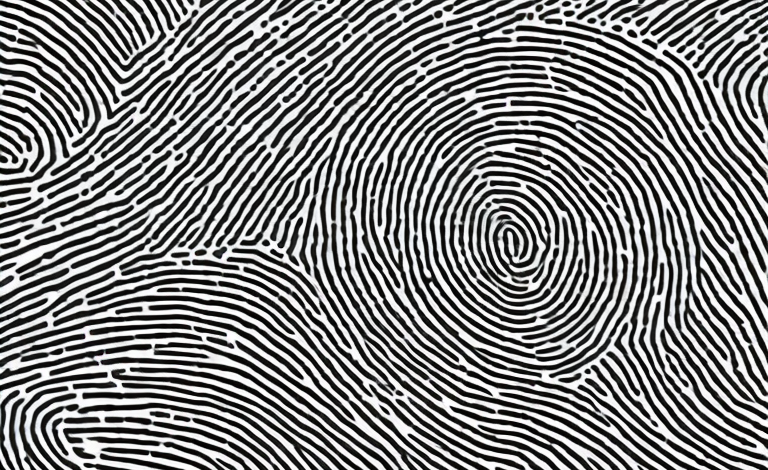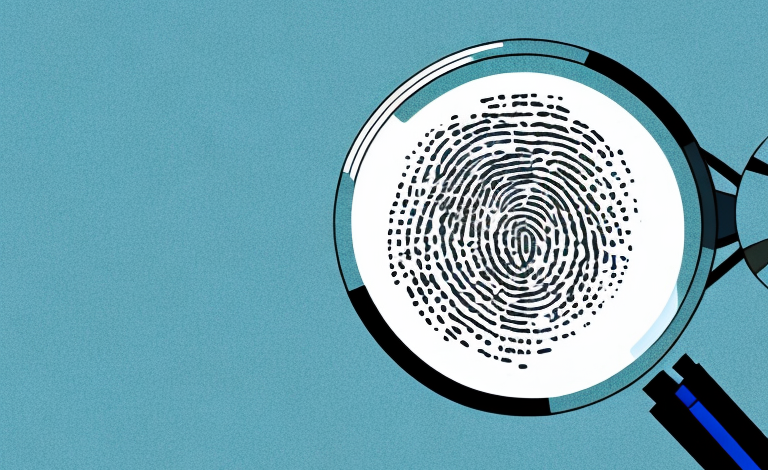Fingerprint analysis has been a popular technique for solving crimes for over a century. One of the key aspects of this technique is understanding the uniqueness of each fingerprint. In this article, we will delve deep into the science behind fingerprint identification, the basics of fingerprint analysis, the types of fingerprints, and their characteristics. We will also consider the history of fingerprinting, the importance of fingerprints in solving crimes, limitations of fingerprint analysis, and the future implications of this field.
Understanding the basics of fingerprint analysis
Fingerprint analysis is a complex process that involves comparing and contrasting patterns, ridges, and pores present on fingers. Each fingerprint pattern is unique, and cannot be duplicated by anyone else. This makes fingerprint analysis an important tool for identifying individuals and solving crimes.
There are three main types of fingerprint patterns: arches, loops, and whorls. Arches are the simplest pattern, with ridges that enter from one side of the finger and exit from the other. Loops have ridges that enter from one side of the finger, curve around, and exit from the same side. Whorls have ridges that form circular or spiral patterns. By analyzing these patterns, forensic experts can determine the type of fingerprint and use it to identify a suspect or victim.
The science behind fingerprint identification
Fingerprint identification is based on the fundamental principle of individuality. The unique characteristics on each finger make it possible to identify a person with a high degree of accuracy. The three main characteristics that forensic experts use to analyze fingerprints are pattern type, ridge characteristics, and pore characteristics. Pattern type refers to the overall pattern of ridges and valleys present on the fingerprint. Ridge characteristics refer to the unique details present on each ridge such as bifurcations, endings, and dots. The pore characteristics refer to the sweat pores that are present on each finger.
One of the most important aspects of fingerprint identification is the use of automated fingerprint identification systems (AFIS). These systems use algorithms to compare and match fingerprints in large databases, making it easier and faster for law enforcement agencies to identify suspects. AFIS technology has greatly improved the accuracy and efficiency of fingerprint identification, and has become an essential tool in solving crimes.
The history of fingerprinting and its evolution
The history of fingerprint analysis dates back to ancient civilizations such as Babylon and China. However, the modern history of fingerprint analysis began in the late 19th century with the work of Sir Francis Galton. In the early 20th century, the concept of using fingerprint identification to solve crimes gained popularity. Over the years, advancements in technology have made it possible to analyze fingerprints with greater accuracy and speed.
Today, fingerprint analysis is not only used in criminal investigations but also in various other fields such as border control, banking, and healthcare. In border control, fingerprints are used to verify the identity of travelers and prevent illegal immigration. In banking, fingerprints are used for secure authentication and to prevent fraud. In healthcare, fingerprints are used to accurately identify patients and prevent medical errors. The evolution of fingerprint analysis has made it an essential tool in various industries, contributing to the safety and security of individuals and organizations.
Different types of fingerprints and their characteristics
There are three main types of fingerprints: loops, whorls, and arches. Loops are the most common type of fingerprint pattern and are characterized by one ridge entering and exiting from the same side. Whorls are circular patterns that have at least two deltas, while arches are the least common fingerprint pattern and have ridges that enter and exit from opposite sides.
Fingerprints are unique to each individual and can be used for identification purposes. The patterns and characteristics of fingerprints are determined by genetics and are formed during fetal development. In addition to the three main types of fingerprints, there are also subtypes such as double loops, central pockets, and tented arches. These subtypes can provide further information for forensic analysis and can help to narrow down potential suspects in criminal investigations.
How do forensic experts collect fingerprints from a crime scene?
Forensic experts use various techniques to collect fingerprints from a crime scene. Some of the commonly used techniques are dusting, cyanoacrylate fuming, and latent print lifting. Dusting involves using a brush or powder to lift fingerprints from surfaces while cyanoacrylate fuming involves using superglue to make fingerprints visible. Latent print lifting involves using specialized tape to lift prints from surfaces.
It is important for forensic experts to properly document the location and condition of the fingerprints found at a crime scene. This documentation can include photographs, sketches, and notes on the type of surface the print was found on. Additionally, experts may use computer software to analyze and compare the collected fingerprints to those in a database in order to identify potential suspects.
Analyzing the uniqueness of each fingerprint
Each fingerprint is unique, and no two fingerprints are alike. This uniqueness makes it possible to identify an individual with a high degree of accuracy. The variability in friction ridges, the presence of unique features such as scars or marks, and the subtle differences between fingerprints make each fingerprint a unique identifier.
In addition to being unique, fingerprints also have a permanence that makes them a reliable form of identification. Fingerprints do not change over time, except in cases of injury or scarring. This means that a person’s fingerprints taken at a young age will be the same as their fingerprints taken later in life. This permanence makes fingerprints a valuable tool in criminal investigations and other identification processes.
Factors that affect the rarity of fingerprints
Several factors affect the rarity of fingerprints. These include environmental factors such as exposure to chemicals, genetic factors, and age. Older individuals tend to have fewer distinctive features on their fingerprints, while exposure to chemicals can alter the quality of fingerprints.
Another factor that affects the rarity of fingerprints is the occupation of an individual. People who work in manual labor jobs tend to have more distinct fingerprints due to the constant use of their hands. On the other hand, individuals who work in office jobs may have less distinct fingerprints due to the lack of manual labor.
Additionally, certain medical conditions can also affect the rarity of fingerprints. For example, individuals with eczema or psoriasis may have altered fingerprints due to the skin condition affecting the ridges on their fingers. This can make it more difficult to identify them through their fingerprints.
Importance of fingerprints in solving crimes
Fingerprint analysis is an important tool for solving crimes. The unique characteristics on each fingerprint make it possible to identify a person with a high degree of accuracy. Fingerprint analysis has helped solve countless crimes and has played a significant role in the criminal justice system.
One of the advantages of fingerprint analysis is that it can be used to link suspects to multiple crime scenes. If a suspect’s fingerprints are found at multiple crime scenes, it can provide strong evidence of their involvement in those crimes. This can be especially useful in cases where there is no other physical evidence linking a suspect to a crime.
Fingerprint analysis has also evolved over time, with new technologies and techniques being developed to improve its accuracy and reliability. For example, automated fingerprint identification systems (AFIS) use computer algorithms to match fingerprints, making the process faster and more efficient. Additionally, forensic scientists can now analyze partial or distorted fingerprints, which were previously unusable, using advanced imaging techniques.
Limitations of fingerprint analysis
While fingerprint analysis is a powerful tool for solving crimes, it does have limitations. Some of the limitations include the existence of partial or distorted prints, the quality of the prints, and the possibility of errors during the analysis process. To mitigate these limitations, forensic experts use multiple techniques to analyze fingerprints and corroborate their findings.
Another limitation of fingerprint analysis is that it can only identify individuals who have previously been fingerprinted and whose prints are in the database. This means that if a criminal has never been fingerprinted before, their identity cannot be determined through fingerprint analysis alone. Additionally, some individuals may have conditions such as eczema or scars that can alter their fingerprints, making them more difficult to analyze.
Despite these limitations, fingerprint analysis remains a valuable tool in forensic investigations. In recent years, advancements in technology have made it possible to analyze even partial or distorted prints, and new techniques such as 3D imaging have improved the accuracy of analysis. As technology continues to evolve, it is likely that fingerprint analysis will become an even more powerful tool for solving crimes.
Common misconceptions about fingerprints and their rarity
There are several misconceptions about fingerprints and their rarity. One common misconception is that fingerprints are completely unique and cannot be replicated. While each fingerprint is unique, it is possible to duplicate certain features or characteristics of a fingerprint. Another misconception is that fingerprints do not change over time. However, fingerprints can change due to various factors such as aging, injuries, or exposure to chemicals.
How technology has changed the way we analyze fingerprints
Advancements in technology have revolutionized the way we analyze fingerprints. The use of computer algorithms and automated systems has made it possible to analyze fingerprints with greater speed and accuracy. Modern technology has also made it possible to analyze fingerprints in a non-invasive way, reducing the risk of contamination or damage.
Future implications of fingerprint analysis in forensic investigations
The future of fingerprint analysis looks bright. Advancements in technology are making it possible to analyze fingerprints with greater accuracy and speed. In the future, we can expect to see more sophisticated techniques and tools for analyzing fingerprints, making it easier to solve crimes and identify individuals.
Case studies showcasing the importance of fingerprints in solving crimes
There are numerous case studies that illustrate the importance of fingerprints in solving crimes. One example is the case of Brandon Mayfield, an American lawyer who was falsely accused of terrorism due to a fingerprint error. After a long legal battle, it was proven that the fingerprint in question did not belong to Mayfield, highlighting the importance of accurate fingerprint analysis.
Frequently asked questions about fingerprint analysis
1. Can two people have identical fingerprints?
No, each fingerprint is unique.
2. Can fingerprints be completely erased?
No, fingerprints cannot be completely erased. However, they can be altered or damaged.
3. Can fingerprints be lifted from any surface?
Fingerprints can be lifted from most surfaces, but some surfaces may require specialized techniques.
4. Can fingerprints change over time?
Yes, fingerprints can change over time due to various factors such as aging or injuries.
5. How long can fingerprints last on a surface?
Fingerprints can last for several days or even weeks on a surface depending on environmental factors.
In conclusion, fingerprint analysis is a powerful tool for solving crimes and identifying individuals. The unique characteristics on each fingerprint make it possible to identify a person with a high degree of accuracy. Advancements in technology have made it easier to analyze fingerprints with greater speed and accuracy, and we can expect to see more sophisticated techniques and tools in the future. While fingerprint analysis does have limitations, it remains a critical part of the criminal justice system and will continue to play an important role in solving crimes.



